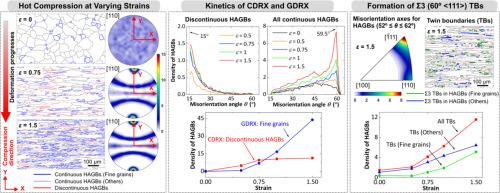Mechanistic insights and kinetics of continuous and geometric dynamic recrystallisation in hot deformed aluminium alloy
IF 8.3
1区 材料科学
Q1 MATERIALS SCIENCE, MULTIDISCIPLINARY
引用次数: 0
Abstract
Dynamic recrystallisation (DRX) is a significant restoration mechanism in the hot deformation of materials with high stacking fault energy (SFE), such as aluminium alloys. Both continuous DRX (CDRX) and geometric DRX (GDRX) have been observed concurrently during hot deformation of aluminium alloys. However, the kinetics of these DRX mechanisms during hot deformation remain considerably controversial in the literature, leading to the development of distinct constitutive models for CDRX and GDRX. To address this knowledge gap, the present study conducted hot compression tests on an aluminium alloy (AA6061) at varying strain levels up to 1.5. Crystallographic orientation and misorientation were characterised over a large area of the deformed samples using high-resolution electron backscatter diffraction (HR-EBSD) with a misorientation resolution of 0.05°. A quantitative analysis was then performed on the characteristics of high-angle grain boundaries (HAGBs), low-angle grain boundaries (LAGBs) and geometrically necessary dislocations (GNDs). The results indicate that CDRX initiates in the early stages of deformation and reaches saturation as deformation progresses. This saturation of CDRX is attributed to a reduction in GNDs and LAGBs. GDRX occurs slightly before CDRX saturation, then accelerates as deformation continues, ultimately becoming the dominant mechanism at higher strain levels. In addition, hot deformation results in formation of Σ3 (60° 〈111〉) twin boundaries (TBs), initially in the original HAGBs and subsequently in new HAGBs produced through GDRX. In contrast, these TBs are not observed in the new HAGBs generated through CDRX. This research provides significant insights into the kinetics of CDRX and GDRX in high SFE materials, supporting the development of predictive models for these DRX mechanisms.


求助全文
约1分钟内获得全文
求助全文
来源期刊

Acta Materialia
工程技术-材料科学:综合
CiteScore
16.10
自引率
8.50%
发文量
801
审稿时长
53 days
期刊介绍:
Acta Materialia serves as a platform for publishing full-length, original papers and commissioned overviews that contribute to a profound understanding of the correlation between the processing, structure, and properties of inorganic materials. The journal seeks papers with high impact potential or those that significantly propel the field forward. The scope includes the atomic and molecular arrangements, chemical and electronic structures, and microstructure of materials, focusing on their mechanical or functional behavior across all length scales, including nanostructures.
 求助内容:
求助内容: 应助结果提醒方式:
应助结果提醒方式:


